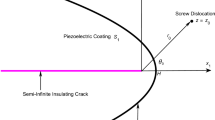Abstract
An exact and closed-form solution is obtained for a screw dislocation near a semi-infinite crack in cubic piezoelectric crystals. The solution is expressed explicitly in terms of two complex functions which contain three major sources: (a) the electromechanical field associated with the isolated dislocation, (b) the attendant fields generated by the “image” singularities of the dislocation, and (c) the interaction between the crack and the dislocation. The shielding or anti-shielding contribution from the dislocation to the electromechanical \(K\)-field of the crack tip is quantitatively assessed. The theoretical findings are discussed and graphically illustrated.



Similar content being viewed by others
References
Chen BJ, Xiao ZM, Liew KM (2004) A line dislocation interacting with a semi-infinite crack in piezoelectric solid. Int J Eng Sci 42:1–11
Chiang CR (2012) The piezoelectric potential of a screw dislocation in a cubic medium. Int J Fract 174:229–236
Chiang CR (2013a) Electromechanical fields around a screw dislocation in a cubic piezoelectric crystal. Eng Fract Mech 99:191–201
Chiang CR (2013b) Mode-III crack problem in a cubic piezoelectric medium. Acta Mech 224:2203–2217
Deeg WF (1980) The analysis of dislocation, crack, and inclusion problems in piezoelectric solids. Ph.D. thesis, Stanford University
Duun ML (1994) The effect of crack face boundary conditions on the fracture mechanics of piezoelectric solids. Eng Fract Mech 48:25–39
Hao T, Shen Z (1994) A new electric boundary condition of electric fracture mechanics and its applications. Eng Fract Mech 47:793–802
Li W, McMeeking RM, Landis CM (2008) On the crack face boundary conditions in electromechanical fracture and an experimental protocol for determining energy release rates. Eur J Mech A/Solids 27:285–301
Lin IH, Thomson R (1986) Cleavage, dislocation emission, and shielding for cracks under general loading. Acta Metall 34:187–206
Mujumdar BS, Burns SJ (1981) Crack tip shielding-an elastic theory of dislocation and dislocation arrays near a sharp crack. Acta Metall 29:579–588
Parton VZ (1976) Fracture mechanics of piezoelectric materials. Acta Astronaut 3:671–683
Suo Z, Kuo CM, Barnett DM, Willis JR (1992) Fracture mechanics for piezoelectric ceramics. J Mech Phys Solids 40:739–765
Author information
Authors and Affiliations
Corresponding author
Rights and permissions
About this article
Cite this article
Chiang, CR. Shielding of a crack tip by its nearby dislocations in cubic piezoelectric crystals. Int J Fract 188, 109–112 (2014). https://doi.org/10.1007/s10704-014-9943-7
Received:
Accepted:
Published:
Issue Date:
DOI: https://doi.org/10.1007/s10704-014-9943-7




